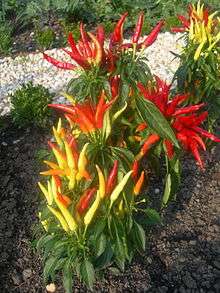Capsicum annuum
| Capsicum annuum | |
|---|---|
 | |
| Scientific classification | |
| Kingdom: | Plantae |
| (unranked): | Angiosperms |
| (unranked): | Eudicots |
| (unranked): | Asterids |
| Order: | Solanales |
| Family: | Solanaceae |
| Genus: | Capsicum |
| Species: | C. annuum |
| Binomial name | |
| Capsicum annuum L. | |
| Varieties | |
| |
| Synonyms[3] | |
| |
Capsicum annuum is a species of the plant genus Capsicum native to southern North America and northern South America.[1][4] This species is the most common and extensively cultivated of the five domesticated capsicums. The species encompasses a wide variety of shapes and sizes of peppers, both mild and hot, ranging from bell peppers to chili peppers. Cultivars are descended from the wild American bird pepper still found in warmer regions of the Americas.[5] In the past some woody forms of this species have been called C. frutescens, but the features that were used to distinguish those forms appear in many populations of C. annuum and there is no consistently recognizable C. frutescens species.[6]
Characteristics

Although the species name annuum means “annual” (from the Latin annus “year”), the plant is not an annual and in the absence of winter frosts can survive several seasons and grow into a large perennial shrub.[7] The single flowers are an off-white (sometimes purplish) color while the stem is densely branched and up to 60 centimetres (24 in) tall. The fruit are berries that may be green, yellow or red when ripe.[8] While the species can tolerate most climates, C. annuum is especially productive in warm and dry climates.
Uses
Culinary
The species is a source of popular sweet peppers and hot chilis with numerous varieties cultivated all around the world.
Common naming in English falls generally in line with the flavor and size of the variant. Larger, sweeter variants are called sweet peppers in Great Britain, and red or green peppers,[9] or "bell peppers" in the United States. The smaller, hotter varieties are called chillis,[10] chilies, chile, or chili peppers.
Capsinoid chemicals provide the distinctive tastes in C. annuum variants. In particular, capsaicin creates a burning sensation ("hotness"), which in extreme cases can last for several hours after ingestion. A measurement called the Scoville scale has been created to describe the hotness of peppers and other foods.
Medicinal
Hot peppers are used in medicine as well as food in Africa[11] and other places around the world.
English botanist John Lindley described C. annuum on page 509 of his 1838 'Flora Medica' thus:
| “ | It is employed in medicine, in combination with Cinchona in intermittent and lethargic affections, and also in atonic gout, dyspepsia accompanied by flatulence, tympanitis, paralysis etc. Its most valuable application appears however to be in cynanche maligna (acute diphtheria) and scarlatina maligna (malignant Scarlet fever, used either as a gargle or administered internally.) | ” |
In ayurvedic medicine, C. annuum is classified as follows:[12]
- Gunna (properties) – ruksh (dry), laghu (light) and tikshan (sharp)
- Rasa dhatu (taste) – katu (pungent)
- Virya (potency) – ushan (hot)
Ornamental
Some cultivars grown specifically for their aesthetic value include the U.S. National Arboretum's Black Pearl[13] and the Bolivian Rainbow. Ornamental varieties tend to have unusually colored fruit and foliage with colors such as black and purple being notable. All are edible, and most (like Royal Black) are hot.
Gallery
_-_dried.jpg) Dried Guajillo chile pod
Dried Guajillo chile pod- Typical C. annuum flower, Royal Embers.
- Bolivian Rainbow with its fruits in different stages of ripeness.
 Five colors of peppers in an Israeli supermarket
Five colors of peppers in an Israeli supermarket Capsicum annuum var. bola or ñora
Capsicum annuum var. bola or ñora Count Dracula
Count Dracula NuMex Memorial Day
NuMex Memorial Day Explosive Embers
Explosive Embers Hungarian wax pepper
Hungarian wax pepper
See also
References
| Wikimedia Commons has media related to Capsicum annuum. |
| Wikispecies has information related to: Capsicum annuum |
- 1 2 "Capsicum annuum L.". Germplasm Resources Information Network. United States Department of Agriculture. 1997-01-22. Retrieved 2010-07-29.
- ↑ Minguez Mosquera, M. I.; Hornero Mendez, D. (1994) "Comparative study of the effect of paprika processing on the carotenoids in peppers Capsicum annuum of the Bola and Agridulce varieties", Journal of Agricultural and Food Chemistry 42(7): 1555-1560
- ↑ "The Plant List".
- ↑ Latham, Elizabeth (2009-02-03). "The colourful world of chillies". Stuff.co.nz. Retrieved 2009-03-08.
- ↑ Francis, John K. (2003-09-09). "Capsicum annuum L. bird pepper - USDA Forest Service" (PDF). Retrieved 2013-09-30.
- ↑ Zhi-Yun Zhang, Anmin Lu & William G. D'Arcy. "Capsicum annuum Linnaeus, Sp. Pl. 1: 188. 1753". Flora of China. 17. pp. 313–313.
- ↑ Katzer, Gernot (May 27, 2008). "Paprika (Capsicum annuum L.)". Retrieved December 1, 2012.
- ↑ Organisation for Economic Co-operation and Development (1 July 2006). Safety assessment of transgenic organisms: OECD consensus documents. OECD Publishing. pp. 299–. ISBN 978-92-64-02258-4. Retrieved 25 November 2011.
- ↑ Pepper
- ↑ Chilli
- ↑ Grubben, G.J.H. & Denton, O.A. (2004) Plant Resources of Tropical Africa 2. Vegetables. PROTA Foundation, Wageningen; Backhuys, Leiden; CTA, Wageningen.
- ↑ "Capsicum Annuum". Retrieved February 21, 2011.
- ↑ "Capsicum annuum "Black Pearl"" (PDF). U.S. National Arboretum. March 2006. Retrieved February 21, 2011.
Further reading
Malgorzata, Materska (March 2015). "Flavone C-glycosides from Capsicum annuum L.: relationships between antioxidant activity and lipophilicity". 240 (3): 549–557. doi:10.1007/s00217-014-2353-2. Arimboor, Ranjith; Natarajan, Ramesh Babu; Menon, K. Ramakrishna; Chandrasekhar, Lekshmi. P; Moorkoth, Vidya (March 2015). "Red pepper (Capsicum annuum) carotenoids as a source of natural food colors: analysis and stability-a review". Journal of Food Science and Technology. 52 (3): 1258–1271. doi:10.1007/s13197-014-1260-7.